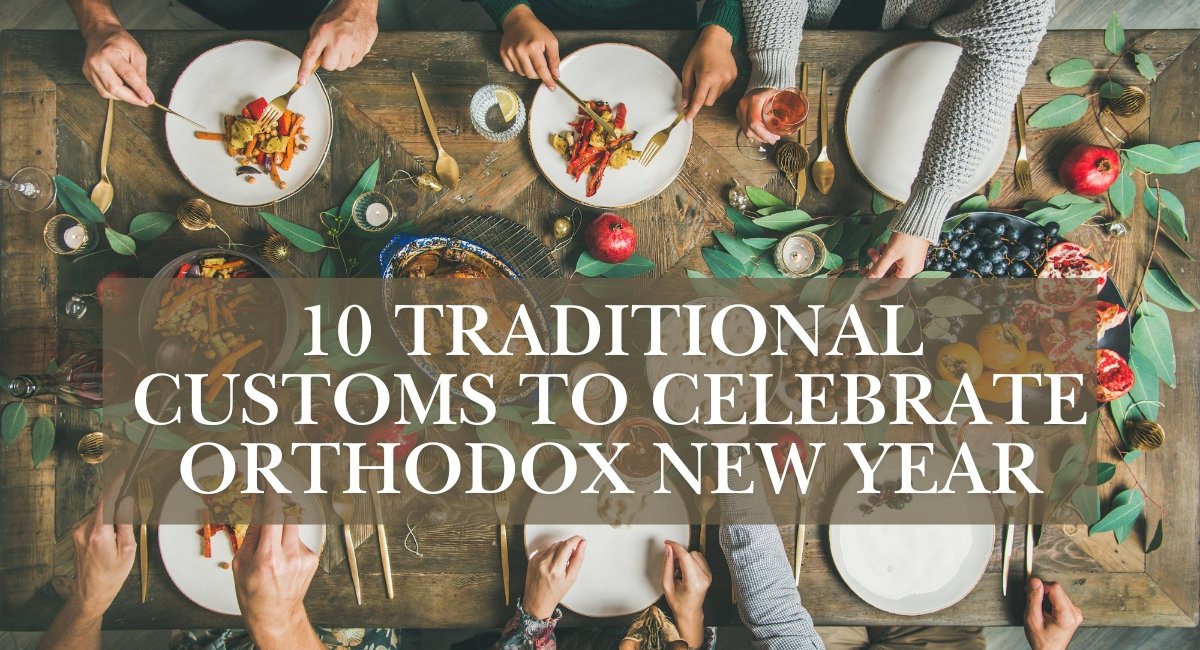10 Traditional Customs to Celebrate Orthodox New Year
This post contains paid and/or affiliate links. I make a small commission at no extra cost to you. Please see our Privacy Policy.
The Orthodox New Year, celebrated on January 14th, is filled with traditions. It marks the start of a new year for many Orthodox Christian communities. Each region has its own way of celebrating this day.
1. Festive Meals
Food is key in Orthodox New Year celebrations. Families come together for big meals with traditional dishes. In Russia, they enjoy Olivier salad and Blinis. In Greece, a cake called Vasilopita is popular, with a coin inside for good luck.
2. Divination Customs
Many cultures use divination to predict the year. In Serbia, they burn oak branches to ward off bad luck and bring prosperity.
3. Special Church Services
Church services are vital for many on Orthodox New Year. In Russia, these services are followed by family gatherings. The ceremonies bless the new year and reflect on the past year.
4. Family Gatherings
Orthodox New Year is about family. Families gather with extended family. This shows unity and hope for the new year.
5. Traditional Music and Dance
Music and dance are big in Orthodox New Year. In Greece and Bulgaria, folk music and dances are common. They add joy and keep traditions alive.
6. Making Wishes
At midnight, people make wishes for the year. In Armenia, they write wishes on paper and burn them. This is believed to carry their hopes to the heavens.
7. New Year’s Resolutions
Making resolutions is a big part of Orthodox New Year. People set goals for self-improvement. This encourages personal growth.
8. The Symbol of the Pine Tree
The pine tree is important in Orthodox New Year. In Russia, homes are decorated with pine branches for longevity. This brings freshness and renewal.
9. Visiting the Graves of Loved Ones
In some cultures, visiting graves is a tradition. In Georgia, families honor their loved ones with flowers and food. They believe it brings peace and blessings.
10. Lighting Candles
Lighting candles is a tradition in many homes. It symbolizes hope and faith for the year. Families light a candle for each member, seeking blessings.
These customs show the rich cultural heritage of Orthodox New Year. They highlight the importance of family, community, and hope for the new year. Participating in these traditions connects us to our roots and brings joy.

The Cultural Significance of Orthodox New Year Customs in Different Countries
The Orthodox New Year is celebrated on January 14th in several countries. It comes from the Julian calendar, 13 days behind the Gregorian calendar. These customs reflect the diversity of traditions and beliefs worldwide.
They show how communities come together to celebrate this special day.
Russia
In Russia, the Orthodox New Year is celebrated with joy. Families come together for dinner, sharing traditional dishes. The Olivier salad is a big hit, mixing veggies and meats.
At midnight, people make toasts, wishing for a prosperous year. Fireworks and fun go late into the night, making it a lively event.
Serbia
In Serbia, the day is called Nova Godina. It’s marked by burning a log called Badnjak. Families light this log, symbolizing warmth and renewal.
They also decorate homes with festive ornaments. Kids go door-to-door singing, strengthening community bonds. This tradition promotes giving and sharing, key to Serbian culture.
Greece
Greece celebrates with the Vasilopita, a cake for Saint Basil. A hidden coin in the cake brings good luck. The person who finds it is blessed.
The cake-cutting is a joyous moment for family and friends. It’s a time of togetherness and happiness.
Georgia
Georgia welcomes the Orthodox New Year with a feast. Churchkhela, a sweet candy, is a favorite. People visit friends and family, sharing food and wishes for health and happiness.
The feast, called supran, is a time to be grateful and together. It emphasizes the importance of community.
Ukraine
Ukrainians make kutia, a sweet porridge, for the Orthodox New Year. It’s made from wheat, honey, and poppy seeds. Families pray together, expressing gratitude and hopes for the New Year.
This tradition strengthens spiritual bonds. It’s a time to connect with ancestors’ spirits.
Bulgaria
Bulgarians celebrate with Surova, where boys in animal hides visit homes. They wish prosperity and receive treats. This custom is playful and highlights the role of youth in traditions.
Romania
Romanian families gather for meals and dances. The Colinda is a tradition where kids sing from house to house. They receive treats and gifts, strengthening social ties.
This creates a festive atmosphere filled with joy and community spirit.
Montenegro
In Montenegro, the Orthodox New Year is celebrated with local flair. People gather and enjoy fireworks. Traditional foods like baklava are a highlight of the feasts.
Moldova
Moldova celebrates with plăcintă, a savory pie. Families share meals, play games, and dance. The hora dance brings everyone together, celebrating community.
Creative Variations Across Countries
These customs share a common goal: to bring people together. Exploring these traditions shows how communities worldwide welcome the New Year with joy and gratitude.
By celebrating these customs, we build connections and respect among cultures. The Orthodox New Year is a time for new beginnings and shared hopes, no matter where you are.
Conclusion
The Orthodox New Year is a lively celebration filled with cultural traditions. These traditions vary by region, showing the beauty of cultural diversity.
From hearty feasts in Russia to family gatherings in Greece, each custom is unique.
These customs are more than just celebrations. They highlight the importance of heritage and shared values like love and togetherness. Together, they form a mosaic of faith and belief, strengthening community bonds.
When you join in Orthodox New Year celebrations, you add to a rich legacy. You might try making traditional dishes or learn about local customs. It’s a way to connect with generations past.
Exploring these customs helps us understand different cultures and their hopes for renewal. As the Orthodox New Year nears, celebrate these traditions. Each act honors the past and looks forward to the future.



